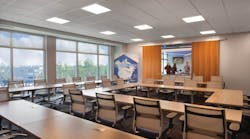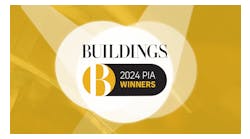Connecting End-to-End Systems in Buildings Through Smart Lighting
Lighting has evolved enabling us to see beyond the dark for a greater purpose. It is more than the bulbs or fixtures select for buildings based on budget or aesthetics. When paired with controls, smart lighting technologies are gaining a larger role than illumination in many industries including healthcare, office, education, aviation, retail and even residential.
Today, lighting with smart light technologies are changing the way we manage facilities; it is impacting our routines, helping us to conserve energy and be more productive. When lighting is connected, its possibilities are vast through the digitally connected end-to-end system. An end-to-end system starts with local networked solutions and can expand to system-wide, unified building automation solutions.
Digital System Center is the Connected Luminaire + Lighting Controls
You do not have to be an electrical engineer to understand how smart building technologies powered by connected luminaires and networked controls can help lower the total costs of ownership of a facility or campus. The nLight lighting controls platform is networked to deliver compelling data collection that can be used as insights to inform cross-functionally—from building owners and business managers to facilities staff.
It evolves with building and business needs to support connection with additional systems while controlling, monitoring and integrating with the lighting and building management systems (BMS).
The Definition of a Connected Luminaire
What is a luminaire? Luminaire is the technical and standard defined term for a complete light unit, as defined by the Illuminating Engineers Society.
At Acuity Brands, we have taken the luminaire a step further, including the innovative technologies that are embedded and/ or connected to a source of light. The result is a simplified installation process with fewer complications than when components are installed separately, with a high quality of light output and eased deliverability.
Here are the components embedded inside the Acuity Brands connected luminaire:
- Driver: controls the specific current of energy flowing to the luminaire
- Wired/Wireless Controls: operate to reduce energy consumption and demand when luminaires are not in use.
- Beacons/Sensors: enabled with Bluetooth® to deliver position accuracy when the beacon is detected by a device.
- Battery Pack: provides additional or back up power during electrical outages or emergencies.
- Gateway/Fog Connector: wireless or wired, device connects to the luminaire to transport data to the fog (secure local/enterprise-specific information storage/sharing) or to the cloud (to securely store/share information privately or with third parties) for the specific use case of the project
As buildings are renovated and retrofitted for modernization, building owners and facilities managers are opting for connected LED luminaires because of their improved functionality and the broad range of features and benefits.
Difference Between Wired vs Wireless Controls
To determine whether wired or wireless controls are needed for a project, the considerations are derived from evaluating the current infrastructure and its capacity for low bandwidth connections. Conditions also consider existing walls or the extent of the building infrastructure—as well as if a mix of both wired and wireless are needed. nLight enabled luminaires can be specified as wired or wireless (or a mix of both) by a lighting agency, contractor or electrical engineer.
Wired controls are daisy-chained or connected via CAT5 cables, which are the standard ethernet connection cable used in IT and building projects. nLight Air wireless controls are connected through Bluetooth® low energy. A knowledgeable specifier, the contracted installer and a systems integrator for more complex projects will collaborate with you during your project to provide the appropriate product suggestions.
BUILDINGS Podcast
How a Smart Building Evolved into a Strategic Asset
Listen to Trevor Palmer discuss the evolution of the smart building.
How do you bridge wired and wireless controls?
Bridging wired and wireless controls are made possible by an embedded LED driver (such as eldoLED®) and a Bluetooth® Low Energy (BLE) radio. Codes or information signals are sent from nearby sensors or beacons to the connected luminaires embedded with nLight. This creates a digital “in luminaire” network. These components are all designed to work together (unified) to enable functions including brighten/dim or tuning the color to a temperature of choice.
The suite of nLight® compatible products are designed with strict security protocols and to work with secure gateway connections to offer clients protected architecture and infrastructure. The security requirements of your organization should also be considered to ensure the connected end-to-end system works within the parameters set by your organization’s IT infrastructure. And, if you intend to use a third party or activate additional services through the connected luminaires, security protocols are one area that should be closely configured and monitored.
Benefits of a Digitally Connected End-to-End System
The quality of light output and performance of LED products gives facilities with connected luminaires an immediately enhanced visual aesthetic to their property for occupants and guests.
For facility managers and maintenance professionals, lighting refresh projects offer a chance to incorporate additional technology advancements that create efficiencies for facility managers, such as enhanced reporting for the building system and higher performing lighting systems.
Another benefit is that connected end-to-end systems are customizable and designed to provide a future-ready infrastructure that is capable of being upgraded, managed and maintained. This lowers the implementation costs for future projects and helps to simplify installation requirements in the future as well because there are fewer devices to install upfront when utilizing connected luminaires.
Connected end-to-end systems enable unified system-wide approaches to energy conservation and overall lighting performance with motion sensing and daylight harvesting sensors, which optimize natural daylight when it enters a space. Integration with a building management system is possible because nLight supports a broad range of protocols and can be used with other products to bridge systems such as HVAC to controllers.
With diagnostic capabilities, connected digital controls can generate specific diagnostics and deliver firmware updates from the driver over the network, ensuring use of the latest security protocols.
Extending the Connected Experience Beyond Facilities Maintenance
A digital connection differentiates a modern connected facility by equipping it with an end-to-end system versus relying on an antiquated building foundation.
The connected experience can extend to other areas and departments outside of facilities maintenance when the business is ready. It can provide an office of operations associates monitoring capabilities for the manufacturing process by providing the metrics for evaluating productivity objectives or asset tracking. And, this is all from leveraging the same connected luminaires that were installed during the renovation or new building phase. Talk about planning for the future.
Need more information to create your smart facility? Download a free report, courtesy of Acuity Brands: “Use IoT to Link Physical Operations and Digital Business” to gain real and practical examples of companies using real-time business insights to address challenges and boost digital processes.
About the Author:
Trevor has held several leadership positions in his 20+ year industry tenure. He is instrumental in positioning Acuity Brands as an industry leader in connected building and lighting control networks, while guiding the company’s strategic development, market expansion and product line diversification.
In his current role, Trevor as SVP Digital Lighting Networks, he drives product marketing, engineering and customer experiences for the entire Acuity Brands business. He is recognized as a building systems expert throughout North America and Europe.
Read more content featuring Acuity Brands experts: Provider Trust Critical to Overcoming Connected Building Challenges

